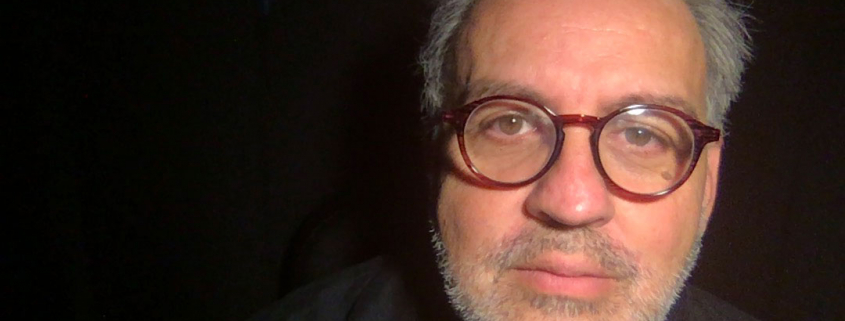Professor transforms LA District into an immersive audio experience

Theatre is magic. Simple as that. Nothing is more thrilling than enjoying art — whether that’s alone or with loved ones.
Chicano playwright, poet and USC associate professor of dramatic writing, Luis Alfaro remains dedicated to bringing authenticity to the world of theatre despite the ongoing coronavirus pandemic.
A native of Pico Union, Los Angeles, Alfaro spent 10 years as a poet and 10 more as a performance artist before working as a playwright.
“In a chance encounter, I met this playwright, María Irene Fornés, a famous Cuban playwright,” Alfaro said. “Then Irene took me on and kind of became a mentor and I started writing plays.”
His career took him across America, Canada, Europe and Latin America. But for Alfaro, L.A. will always be home.
“Being Mexican-American, having grown up in downtown L.A. is basically the essence of every single thing I do,” Alfaro said. “I write from a varied perspective of L.A. I write about what it means to be a person of color living in L.A., working in L.A.”
Heart and pride in his identity is at the forefront of Alfaro’s work — including in his upcoming immersive audio play, “March of Time — Time Warp.”
“Chalk Lines,” a series of audio plays, is being released by Chalk Repertory Theatre. The plays focus on storytelling representative of and created by historically unexplored communities in L.A.
The play follows a candid tour guide, played by actress Emily Kuroda, who ushers the listeners through more than 150 years of Los Angeles history.
On June 19, the play can be enjoyed online at home or at the locations it documents, such as Union Station, Chinatown, the Los Angeles Memorial Coliseum and more. The play is free and will be available for six months.
The cast is stocked with talent from Kuroda to recent School of Dramatic Arts alumnus Tonatiuh Elizarraraz.
Kuroda is a seasoned actor, having worked previously with Alfaro and having a fan favorite role on “Gilmore Girls.” During her youth, Kuroda recalls speaking very little, but everything changed when she began acting in high school.
“Through grade school I probably just said a few words, and then in high school when I discovered drama, where you could read other people’s words without putting your own self on the line — I said this is a godsend,” Kuroda said. “I got to express my feelings, my fears, my joys, without having to expose myself under the guise of someone else’s words.”
Kuroda found her perfect match. Right at the start of her career, Kuroda worked with Alfaro. Even now, she adores working with his writing because it is focused not only on the narrative but also the emotional arc of the story.
Alfaro jumped at the opportunity to write for “Chalk Lines,” thrilled to write a short play involving a lot of sound.
While the piece hops through generations, the modes of transportation change as well, allowing the audio team to expend their full talents.
Sound team Justin Asher and Colin Wambsgans, relished the opportunity to play around with the project’s design. Wambsgans is known for his sound work at concerts, installations, podcasts, films, plays, apps and then some. Asher is a L.A. based composer, audio producer and sound designer.
“[With] a lot of other plays, we really have to get focused and do a lot of fine tuning to have it sound like a very specific place,” Wambsgans said. “[Alfaro’s play] gives us a lot of room for more creativity on our end.”
Having worked together on numerous projects, Wambsgans and Asher perfected their process of crafting sound design experiences.
“What is the sound supposed to convey in the end?” Asher said. “A lot of what [we] do with the sound is figure out how to make it sound like it’s in the place where it’s supposed to be.”
While the play’s settings may elicit vivid sensory experiences from its listeners, the vision of the script permitted the sound team to explore the play’s atmosphere.
“The world we’re supposed to create … is much more imaginary, it’s a much more sort of expressionistic world,” Asher noted. “It’s a fun challenge, but it leaves a lot up to the imagination, which is a lot of fun.”
The sound in the audioplay transports listeners from the Chinese Massacre of 1871 to organizing in the 1900s to the rapid demographic changing of neighborhoods like East L.A. Boyle Heights.
“Initially it was supposed to be a walking tour for people [to] follow the sites that were being talked about. But then what happened because of the pandemic is we had to switch to making an audio tour,” Alfaro said. “So I’m hoping that people still go on the journey … but what I love is being able to take the audience, not just on a physical journey through a district but also taking people on an audio journey of what is Los Angeles.”
Alfaro chose to write about a district of L.A. that runs from Chinatown to 96th and Figueroa. Throughout his research process he was surprised by the size of the district but also the unique deep history that runs throughout it.
“There was a lot of … redlining, there was a lot of public housing, but also there was a lot of racism,” Alfaro said. “People built neighborhoods then they were kicked out of neighborhoods, and that primarily happened for the Asian community and Black community.”
His interest was piqued at the opportunity to show how L.A. was made through this mode of storytelling.
“I’m a political artist — I don’t hide from that. I came to art to change the world, so I’m less interested in art as an art piece and more interested in how we use art to create social change,” Alfaro said. “For me, it’s the lasting changes. How do we use art to inspire people to want to change their lives?”

